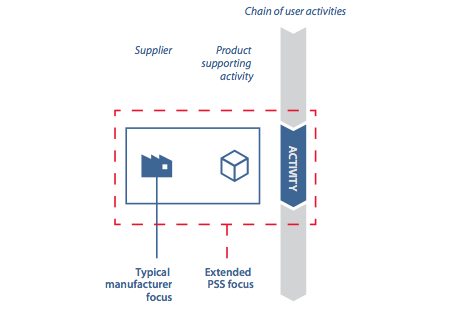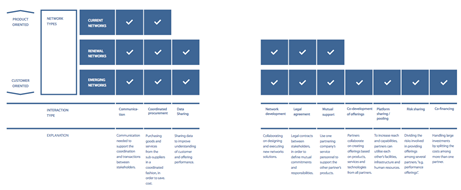This sixth book in PROTEUS’ seven-book series describes why partnerships and networks are crucial factors in delivering successful PSS solutions. The workbook uses theoretical considerations and case examples to establish an understanding of maritime PSS networks and partnerships. Based on this understanding, the book goes on to provide a number of recommendations for how suppliers can start building networks based on PSS.
The workbook starts by providing a thorough description of relevant dimensions concerning maritime PSS partnerships. Some of these domains are key to understand the very nature of service-oriented business models such as the expansion of business focus when entering service business.

Expanding focus for PSS manufacturer
Other relevant dimension is the introduction of the novel concept of value networks, replacing the notion of value chains, given that when supporting a customer activity by coordinating offerings with other suppliers, or when including sub-suppliers in the (internal) activity of developing new solutions, the notions of upstream/ downstream and a linear progression of value chains break down.

Suppliers entering shared domains due to an expanded PSS focus.
To enter into such new domains of collaboration, means to create new interactions between suppliers, who then create new types of value networks. The workbook describes the types of networks and interactions according to how advanced the collaboration is.

Network and interaction types - [click image to enlarge]
Moreover the drivers for such collaborations are explained in detail. Two main driver categories are outlined: a market pull, where one company has been able to identify a demand in the market still being unable to meet the demand alone; and capability push, where existing network members enter on mutual exploration of the partnering organisation's capabilities for a given customer activity.
After describing the relevant dimensions of maritime PSS partnerships, the workbook moves on to present three case studies of such industry partnerships. The cases presented are the Green Ship of the Future, a joint venture of maritime companies in retrofitting packages and the case of MAN Diesel PrimeServ and Alfa Laval on creating academies.
The workbook concludes by providing general guidelines for building a PSS partnership. Attention is brought to issues regarding initial clarification of the need for such a partnership, ways to explore the potential benefits and risks, recommendations when initiating the partnerships and the rollout and operation of the network. Each area is described in detail.